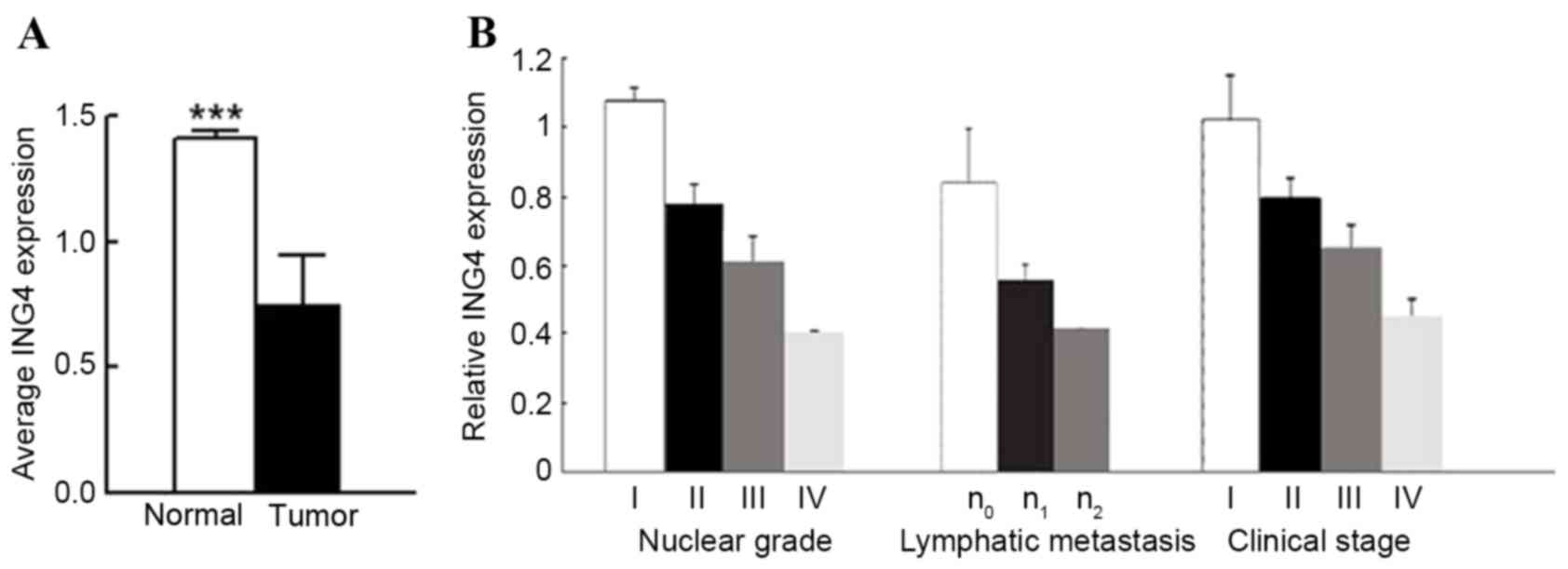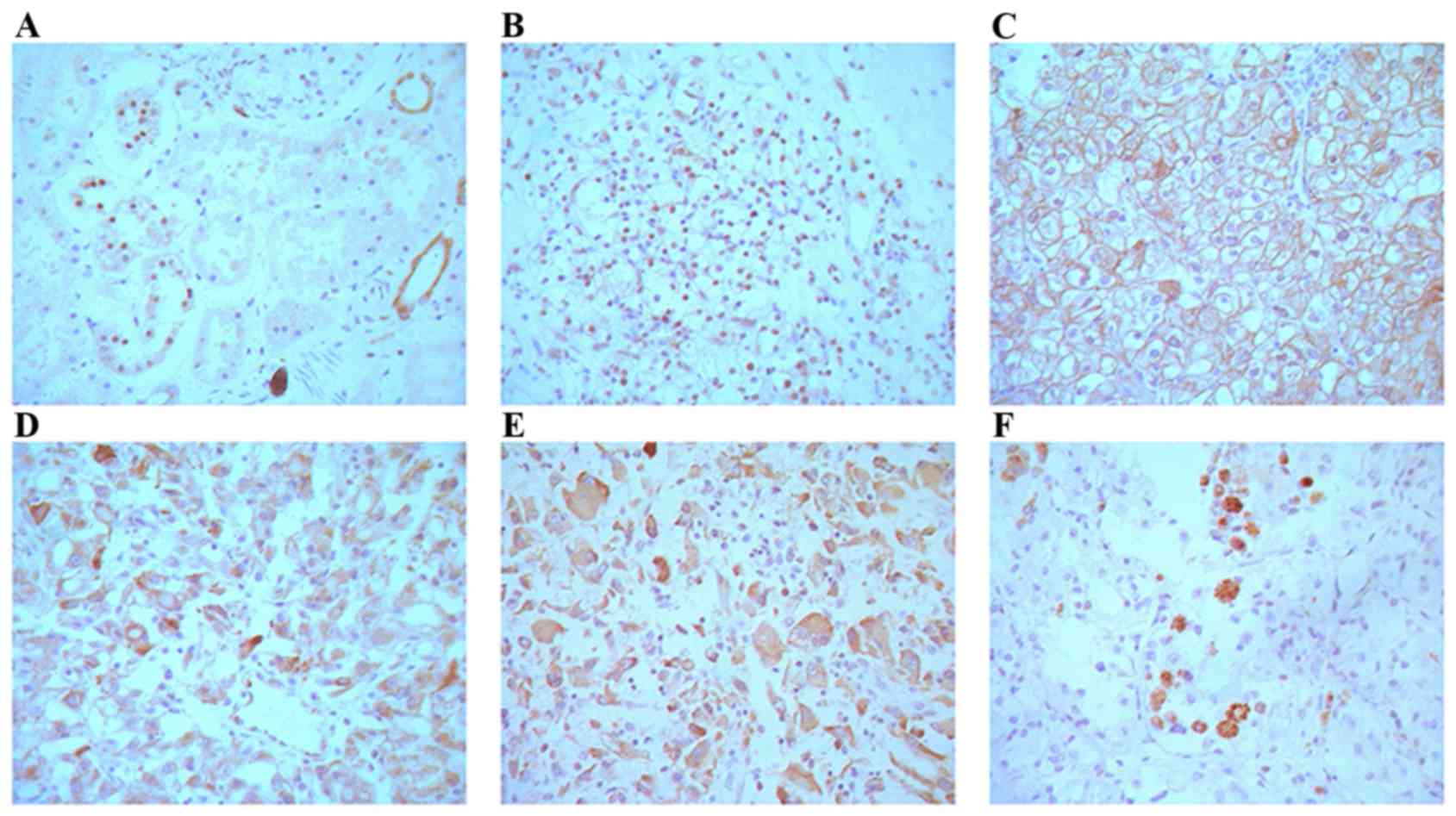|
1
|
Garkavtsev I, Kazarov A, Gudkov A and
Riabowol K: Suppression of the novel growth inhibitor p33ING1
promotes neoplastic transformation. Nat Genetics. 14:415–420. 1996.
View Article : Google Scholar : PubMed/NCBI
|
|
2
|
Garkavtsev I and Riabowol K: Extension of
the replicative life span of human diploid fibroblasts by
inhibition of the p33ING1 candidate tumor suppressor. Mol Cell
Biol. 17:2014–2019. 1997. View Article : Google Scholar : PubMed/NCBI
|
|
3
|
Garkavtsev I, Kozin SV, Chernova O, Xu L,
Winkler F, Brown E, Barnett GH and Jain RK: The candidate tumour
suppressor protein ING4 regulates brain tumour growth and
angiogenesis. Nature. 428:328–332. 2004. View Article : Google Scholar : PubMed/NCBI
|
|
4
|
Gunduz M, Nagatsuka H, Demircan K, Gunduz
E, Cengiz B, Ouchida M, Tsujigiwa H, Yamachika E, Fukushima K,
Beder L, et al: Frequent deletion and down-regulation of ING4, a
candidate tumor suppressor gene at 12p13, in head and neck squamous
cell carcinomas. Gene. 356:109–117. 2005. View Article : Google Scholar : PubMed/NCBI
|
|
5
|
Kim S, Chin K, Gray JW and Bishop JM: A
screen for genes that suppress loss of contact inhibition:
Identification of ING4 as a candidate tumor suppressor gene in
human cancer. Proc Natl Acad Sci USA. 101:pp. 16251–16256. 2004;
View Article : Google Scholar : PubMed/NCBI
|
|
6
|
Guo Y, Meng X, Wang Q, Wang Y and Shang H:
The ING4 binding with p53 and induced p53 acetylation were
attenuated by human papillomavirus 16 E6. PLoS One. 8:e714532013.
View Article : Google Scholar : PubMed/NCBI
|
|
7
|
Masayuki S, Makoto N, Pedeux RM,
Kitahama-Shiseki M, Miura K, Okamura S, Onogi H, Higashimoto Y,
Appella E, Yokota J and Harris CC: p29ING4 and p28ING5 bind to p53
and p300, and enhance p53 activity. Cancer Res. 63:2373–2378.
2003.PubMed/NCBI
|
|
8
|
Liu E, Wu J, Cao W, Zhang J, Liu W, Jiang
X and Zhang X: Curcumin induces G2/M cell cycle arrest in a
p53-dependent manner and upregulates ING4 expression in human
glioma. J Neurooncol. 85:263–270. 2007. View Article : Google Scholar : PubMed/NCBI
|
|
9
|
Russell M, Berardi P, Wei G and Riabowol
K: Grow-ING, Age-ING and Die-ING: ING proteins link cancer,
senescence and apoptosis. Exp Cell Res. 312:951–961. 2006.
View Article : Google Scholar : PubMed/NCBI
|
|
10
|
Nagashima M, Shiseki M, Pedeux RM, Okamura
S, Kitahama-Shiseki M, Miura K, Yokota J and Harris CC: A novel
PHD-finger motif protein, p47ING3, modulates p53-mediated
transcription, cell cycle control, and apoptosis. Oncogene.
22:343–350. 2003. View Article : Google Scholar : PubMed/NCBI
|
|
11
|
Tapia C, Zlobec I, Schneider S, Kilic E,
Güth U, Bubendorf L and Kim S: Deletion of the inhibitor of growth
4 (ING4) tumor suppressor gene is prevalent in human epidermal
growth factor 2 (HER2)-positive breast cancer. Hum Pathol.
42:983–990. 2011. View Article : Google Scholar : PubMed/NCBI
|
|
12
|
Wang QS, Li M, Zhang LY, Jin Y, Tong DD,
Yu Y, Bai J, Huang Q, Liu FL, Liu A, et al: Down-regulation of ING4
is associated with initiation and progression of lung cancer.
Histopathology. 57:271–281. 2010. View Article : Google Scholar : PubMed/NCBI
|
|
13
|
Organization WH, Ferlay J, Pisani P and
Parkin DM: Globocan 2000: Cancer incidence, mortality and
prevalence worldwide. Bray Freddie. 2001.
|
|
14
|
Zbar B, Klausner R and Linehan WM:
Studying cancer families to identify kidney cancer genes. Annu Rev
Med. 54:217–233. 2003. View Article : Google Scholar : PubMed/NCBI
|
|
15
|
Fang F, Luo LB, Tao YM, Wu F and Yang L:
Decreased expression of inhibitor of growth 4 correlated with poor
prognosis of hepatocellular carcinoma. Cancer Epidemiol Biomarkers
Prev. 18:409–416. 2009. View Article : Google Scholar : PubMed/NCBI
|
|
16
|
Cai L, Li X, Zheng S, Wang Y, Li H, Yang J
and Sun J: Inhibitor of growth 4 is involved in melanomagenesis and
induces growth suppression and apoptosis in melanoma cell line M14.
Melanoma Res. 19:1–7. 2009. View Article : Google Scholar : PubMed/NCBI
|
|
17
|
Edge SB and Compton CC: The American Joint
Committee on Cancer: The 7th edition of the AJCC cancer staging
manual and the future of TNM. Ann Surg Oncol. 17:1471–1474. 2010.
View Article : Google Scholar : PubMed/NCBI
|
|
18
|
Livak KJ and Schmittgen TD: Analysis of
relative gene expression data using real-time quantitative PCR and
the 2(−Delta Delta C(T)) method. Methods. 25:402–408. 2001.
View Article : Google Scholar : PubMed/NCBI
|
|
19
|
Zhao W, Yang L, Wang L, Zuo W, Yuan S, Yu
J, Yu Q, Hu X, Wang S, Liu N, et al: Primary clear cell carcinoma
of nasal cavity: Report of six cases and review of literature. Int
J Clin Exp Med. 7:5469–5476. 2014.PubMed/NCBI
|
|
20
|
Zhang X, Wang KS, Wang ZQ, Xu LS, Wang QW,
Chen F, Wei DZ and Han ZG: Nuclear localization signal of ING4
plays a key role in its binding to p53. Biochem Biophys Res Commun.
331:1032–1038. 2005. View Article : Google Scholar : PubMed/NCBI
|
|
21
|
Li M, Jin Y, Sun WJ, Yu Y, Bai J, Tong DD,
Qi JP, Du JR, Geng JS, Huang Q, et al: Reduced expression and novel
splice variants of ING4 in human gastric adenocarcinoma. J Pathol.
219:87–95. 2009. View Article : Google Scholar : PubMed/NCBI
|
|
22
|
Yang HC, Sheng WH, Xie YF, Miao JC, Wei WX
and Yang JC: In vitro and in vivo inhibitory effect of Ad-ING4 gene
on proliferation of human prostate cancer PC-3 cells. Ai Zheng.
28:1149–1157. 2009.(In Chinese). PubMed/NCBI
|
|
23
|
Raho G, Miranda C, Tamborini E, Pierotti
MA and Greco A: Detection of novel mRNA splice variants of human
ING4 tumor suppressor gene. Oncogene. 26:5247–5257. 2007.
View Article : Google Scholar : PubMed/NCBI
|
|
24
|
Bleumer I, Oosterwijk E, De Mulder P and
Mulders PF: Immunotherapy for renal cell carcinoma. Eur Urol.
44:65–75. 2003. View Article : Google Scholar : PubMed/NCBI
|












